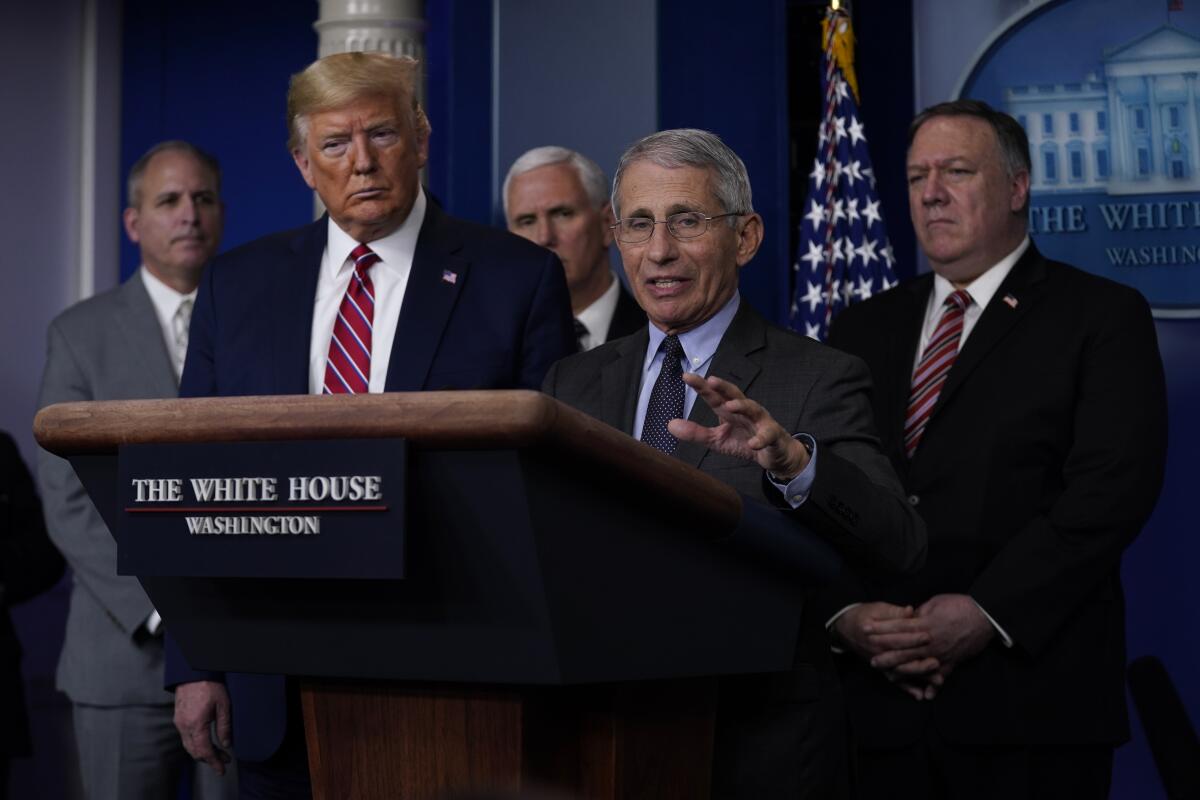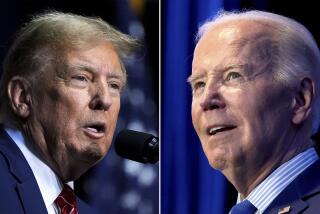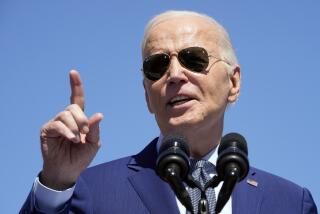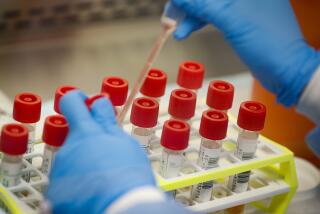Even the coronavirus crisis can’t bridge America’s partisan divide

- Share via
WASHINGTON — The coronavirus is a fearsome, vicious foe. But that’s not been enough to unite America. At least not yet.
The United States has become so politically polarized that even Americans’ view of the pandemic is split along party lines, polls show. For President Trump, that means he hasn’t enjoyed any rally-round-the-flag surge of support, as presidents sometimes do during national calamities. But neither has he seen his support drop, despite extensive criticism of his administration’s response to the crisis.
Polls released over the last week have found that Democrats were much more likely than Republicans to see the coronavirus as a threat to the country’s health, to fear for their family’s well-being, to see major life changes ahead, and to think that the worst is yet to come. They were even more likely to look online for hand sanitizer.
Republicans were more sanguine, more likely to think that the news media are exaggerating the risks. And they have been twice as likely as Democrats to believe a theory that scientists say is false — that the coronavirus was created in China as a bio-weapon. China responded with its own unfounded theory, suggesting that visiting U.S. Army troops brought the disease to Wuhan, the epicenter of the pandemic.
That may change among Republicans who take their cue from Trump: He abruptly took a more serious tone this week, after downplaying the danger to Americans for weeks.
With confirmed infections in all 50 states plus U.S. territories, the United States hit two grim landmarks Friday — more than 200 deaths and more than 14,000 confirmed cases.
Everyone — including Republicans — likely will take the contagion more seriously as caseloads and deaths steadily mount and the economy tanks further. For now, the pandemic has hit hardest on the East and West Coasts, in urban areas that are heavily Democratic.
In Italy, which has suffered the most deaths of any country from COVID-19, the disease caused by the coronavirus, an Ipsos poll in late February found that about 80% believed the media were exaggerating the risk of the outbreak. Two weeks later, as the death toll soared, only 29% said that.
Increasing experience with the disease may also narrow the partisan perception gap.
In Washington state, one of the worst-hit states, a poll taken by Survey 160 and Gradient Metrics found 49% of Republicans and 12% of Democrats said the crisis was generally exaggerated. That was a significant partisan gap, but smaller than the poll found nationally: 73% of Republicans and 26% of Democrats said the threat was exaggerated.
“While partisanship continues to structure public opinion, the facts on the ground can ultimately break through when the situation is grave enough,” said Kevin Collins, chief research officer of Survey 160, which conducts polls using phone texts and works for Democratic and nonprofit organizations.
Brian Schaffner, a political scientist at Tufts University outside Boston, found an unusual window onto the partisan divide — and signs that it may be narrowing.
He discovered a big gap between Republicans and Democrats by analyzing Google searches for “hand sanitizer.” He reported on Twitter that the differences began to diminish in the days since Trump shifted his tone to acknowledge the “seriousness of the threat.”
Partisan differences were stark in a poll released Wednesday by the nonpartisan Pew Research Center, which found that 59% of Democrats regarded COVID-19 as a major threat to U.S. health compared to 33% of Republicans who did. Nearly eight in ten Democrats said Trump was minimizing the risks involved; less than a quarter of Republicans said he was.
The survey also found that three in ten Republicans — twice as many as Democrats — believed a fringe theory spread on news and social media that COVID-19 was manufactured in a lab and was not a product of nature.
The latest Wall Street Journal/NBC News poll found that 79% of Democrats said they believed the worst of the outbreak was yet to come — almost twice as many as Republicans. Two-thirds of Democrats said they worried they or their family would become infected, compared with 40% of Republicans.
And more than twice as many Democrats said they expected their daily lives to change in a major way as a result of the pandemic.
The partisan split on the health crisis is the latest and a particularly striking example of the growing polarization of American opinion over the last generation, which has accelerated in the Trump era. Increasingly, polls find that Americans’ view of the state of the economy, for example, has more to do with their political allegiance than the actual state of the economy.
A Wall Street Journal/NBC News poll in mid-2015 found that just 22% of Republicans were satisfied with the state of the economy. In April 2017, a few months after Trump had taken office, 66% were satisfied.
“We’ve gotten to the point in this where polarization and partisan antipathy is so strong that people are reinterpreting basic facts” through a partisan lens, said Mark Mellman, a Democratic pollster.
Americans are now more polarized in part because of the explosion of politically targeted news media: Fox News, a favorite of Trump and his GOP followers, echoed the president for weeks when he downplayed the growing coronavirus threat. More liberal channels dwelled on the potential health calamity and Democrats’ criticism of Trump’s handling of the crisis.
The state of emergency has produced little discernable impact on Trump’s overall approval rating so far.
The Journal/NBC poll found that Trump’s job approval has remained stable at 46%. A similar stability was found in the rankings of leaders across the globe, according to a survey of opinion data from 40 countries and territories compiled by GQR, a Democratic polling firm in the U.S.
“There are no signs of any global public leaders or institutions getting sky high ratings for their handling of the coronavirus,” the GQR report said. “Yet negative impacts on the overall support levels for many leaders appear to be relatively limited.”
This is in sharp contrast to the public reaction to the Sept. 11 terrorist attacks, when “rally around the flag” sentiment was strong. After the 2001 attacks, President George W. Bush’s approval rating soared to 90% in the Gallup Poll — the highest for any president in the poll’s history. Even two months later, Bush’s job approval remained 97% among Republicans, 75% among Democrats, according to the Pew Research Center, although it fell sharply after that.
By contrast, Pew’s recent survey found, when asked about Trump’s handling of the coronavirus crisis, seven times as many Republicans as Democrats expressed confidence in him.
A pandemic is of course a very different calamity than a clearly defined act of terrorism or foreign aggression.
Trump has increasingly referred to the pandemic as the “Chinese coronavirus,” as if it had a nationality, because the first outbreak was detected there.
“Sept. 11 was someone from outside of the country trying to attack the country,” said Mellman. “Trump is trying to make it from China, but it is not an outside power. It is nature.”
Trump may have lost whatever opportunity he had to forge a sense of national unity by the way he has handled the crisis: first blaming Democrats and the media for perpetrating a “hoax” by exaggerating the danger; then declaring a national emergency, then telling Americans to “just relax,” even as he denies responsibility for any early misjudgments
Robert Blendon, professor of health policy and political analysis at the Harvard T.H. Chan School of Public Health, said it is usually politically risky for a politician to step out front on such health emergencies.
President Gerald Ford, for example, paid a price in his 1976 reelection campaign after he led the charge for national vaccinations against the swine flu. The epidemic proved not to be as serious as expected, and the vaccine caused crippling side effects in hundreds of people. It contributed to Ford’s loss at the ballot box that November.
“In a national emergency, it’s not good for the health of a politician to get out front,” said Blendon. “There is a great deal of uncertainty.”
More to Read
Get the L.A. Times Politics newsletter
Deeply reported insights into legislation, politics and policy from Sacramento, Washington and beyond. In your inbox three times per week.
You may occasionally receive promotional content from the Los Angeles Times.











